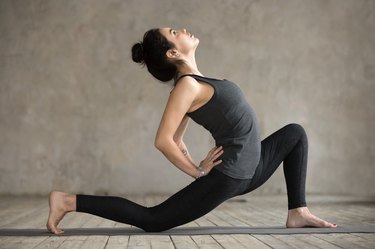
You might not think much about your hip flexors that cross the front of your thigh. But, chances are, you've felt them while doing hip stretches or activities that require kicking or running.
The hip flexor muscles are attached to the hip joint to allow the femur, which is the upper leg bone, to flex onto the pelvis region. In simpler terms, the hip flexor muscles allow the knee to raise and move the thigh upward. The hip is a large, deep and stable ball and socket joint that is surrounded by many ligaments, tendons and muscles.
Video of the Day
Video of the Day
Tip
Hip flexion — raising your thigh upward — is primarily performed by the iliopsoas, sartorius and rectus femoris muscles.
1. Iliopsoas
The iliopsoas muscle group consists of two muscles: the psoas muscle and the iliacus muscle. These muscles work together to flex the hip. To a lesser extent, they also help with rotation of your spine.
The psoas muscle originates on lumbar vertebrae — L1 through L5 — located in your lower back. The other end of the psoas muscle connects via a tendon to the femur bone. The lumbar plexus, a nerve bundle that originates at the lower end of the spine, controls the psoas muscle.
The iliacus muscle connects to the ilium — the largest bone of the pelvis — then travels under the psoas muscle to join it's tendon to connect to the femur bone. The iliacus muscle is controlled by the femoral nerve, located in the front of the thigh.
2. Sartorius
The sartorius muscle originates on the front of the top of your pelvis. The muscle crosses the front of the thigh to attach to the tibia, also known as the shin bone. The femoral nerve supplies the sartorius muscle.
In addition to hip flexion, the sartorius muscle aids in knee flexion, rotating the thigh away from the body and moving the thigh out to the side. In combination, this movement brings the leg into a "figure 4" sitting position.
The sartorius is sometimes called the "tailor's muscle." Because of its function, this muscle often became enlarged in tailors, who tended to sit in the figure 4 configuration.
Read more: 4 Tips for Getting Rid of Hip Flexor Pain
3. Rectus Femoris
The rectus femoris is the largest and most superficial of the four quadriceps muscles — the major muscle group at the front of the upper leg. The rectus femoris runs from the front of the pelvis, across the patella (or kneecap) to attach to the tibia in the lower leg. It is powered by the femoral nerve.
The rectus femoris is the only quad muscle that crosses both the hip and the knee joints, giving it dual function as a hip flexor and knee extender.
Hip Flexor Exercises
Many people spend the majority of their day sitting, whether at work or while commuting. This puts the hip flexor muscles in a shortened position. Perform hip flexor exercises daily to improve flexibility in this muscle group.